Sometimes you just want to drive a car that seems to place your butt at the same height as the pedals, where the instruments are just below your eye-level, where the road is so close to your eyes each driving sensation gets visually amplified. If you’re in a mood like this, take the 2019 Toyota 86 for a spin.
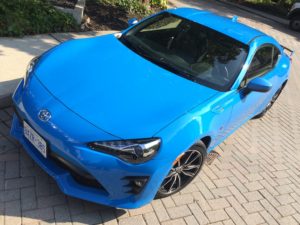
First impressions
The Neptune Blue 86 GT drew its share of compliments, both for the body colour and for the shape.
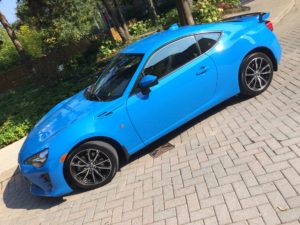
Toyota’s stylized “86” logo dots the outside (and inside) of the vehicle.
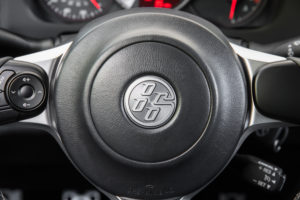
image courtesy Toyota
It began its existence as a Scion FRS, developed jointly with Subaru, which manufactures the vehicles and calls its version the BRZ. With Scion’s demise, Toyota brough the FRS into the main family fold, along with a few of its siblings.
The hood sits noticeably lower to the ground than that of other vehicles thanks to the 2.0L 4-cylinder boxer engine underneath. Prominent bumps above the front wheel wells frame the driver’s view, while the roof offers a valley of sorts between spots for the driver’s and passenger’s heads. That roof slopes back to a steeply raked rear window, which leads to a spoiler on the hood deck.
Interior
Getting into the 86 can be challenging, but once you’re inside, you’re solidly held by manually adjustable heated bucket seats featuring firm side bolsters that will keep your torso in place.
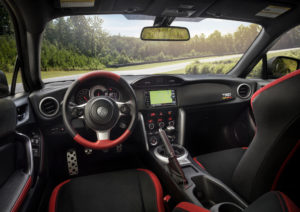
image courtesy Toyota. TRD version shown.
The fit is tight. The leather steering wheel is directly ahead and just about vertical to the ground. Other racing-type touches include a shift lever that leans to the right. At first glance, this lean suggests the transmission is manual. It’s a good deception, since my tester was an automatic.
Controls on the centre console are laid out simply. Dual climate controls consist of three dials/buttons plus five retro metal-look switches.
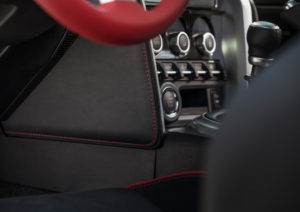
image courtesy Toyota. TRD version shown.
Just below, there’s one USB port next to a small slot that holds half a phone. Above the HVAC controls is a digital clock and hazard lights button. The ensemble is topped off by the touchscreen and two HVAC vents.
As with most sport coupes this size, the rear seat won’t fit full-grown adults with legs any thicker than hockey sticks. This is a two-door car and, in fact, a two-seater.
Hockey bag test
Add a hockey bag and the 86 becomes a one-seater.
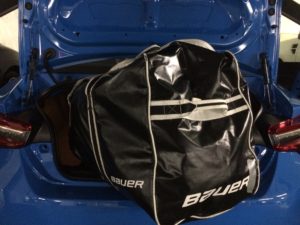
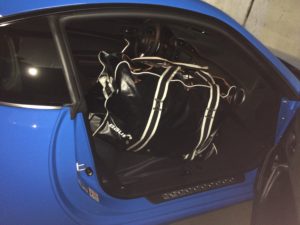
Sticks went through the fold-down rear seat (the entire seatback folds down as one unit).
I wish Toyota had extended the trunk lid to include the rear window. That would have made the trunk useful for more than an overnight bag or two.
In-cabin technology
In the 86, like in several other Toyotas, you’ll find the rearview camera not in the dashboard but as a small rectangle in the rear-view mirror. I like Toyota’s innovation here: I find I look both forward and backward at the same time.
There is a 7” touchscreen, but the 86 I drove did not offer the full complement of features that cars in this price range increasingly offer. There’s no satellite radio, navigation, hands-free phone or Apple CarPlay, for instance.
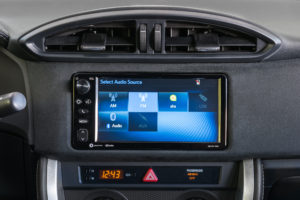
image courtesy Toyota
Music came through 8 speakers, though I often preferred the engine noise each time I tapped the accelerator pedal.
Driving
The 2.0L 4-cylinder boxer engine produces peak horsepower and torque figures are 200 and 151, respectively. Those numbers are 5 units higher if you opt for the manual transmission. These aren’t barnstorming numbers, but the 86 is quick and feels quicker thanks to how low the driver sits to the ground. It is a rear-wheel drive, so steering feel is different, and thanks to stability and traction control, you must push the 86 hard before it no longer sticks to the ground.
The 86 ships with a Sport drive mode button, as well as one for Snow.
Toyota ships the automatic with steering-wheel-mounted paddle shifters. For a real racing feel, you can set the instrument cluster screen to show “performance“ numbers instead of the fuel-economy summary I stuck to during my week with the car. The suspension doesn’t ride super-stiff, but I took residential, speed-bump-endowed residential roads just a little slower.
Parking the 86 was simple enough, though the turning radius didn’t enable U-turns on roads where other models do.
Fuel economy
It’s difficult to bring combined fuel economy below 8 L/100km, which I figured I might be able to do given how small the car and engine happen to be. This car is tuned towards performance first and foremost, so don’t expect that easy a ride at the pumps.
Conclusions
This modestly-powered sports car is a fun runabout that could use a few infotainment system upgrades. You might overlook those once you’ve taken it for a spin thorugh a few curves.
Pricing
The 86 I drove retails for $36,332.50 MSRP, including various charges and fees. The base 2019 86 starts at $29,990 MSRP.